The AMD Trinity Review (A10-4600M): A New Hope
by Jarred Walton on May 15, 2012 12:00 AM ESTAMD Trinity General Performance
Starting as usual with our general performance assessment, we’ve got several Futuremark benchmarks along with Cinebench and x264 HD encoding. The latter two focus specifically on stressing the CPU while PCMarks will cover most areas of system performance (including a large emphasis on storage) and 3DMarks will give us a hint at graphics performance. First up, PCMark 7 and Vantage:
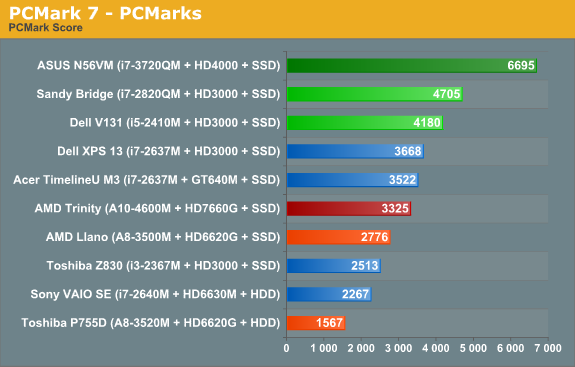
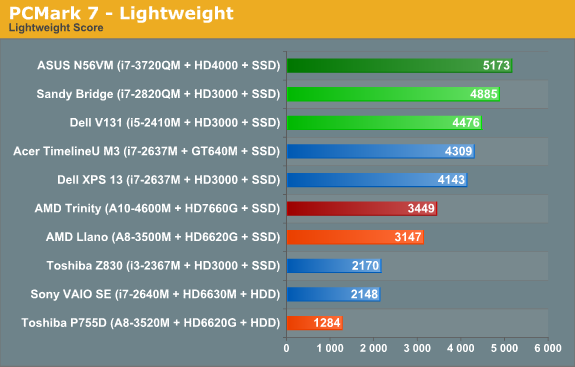
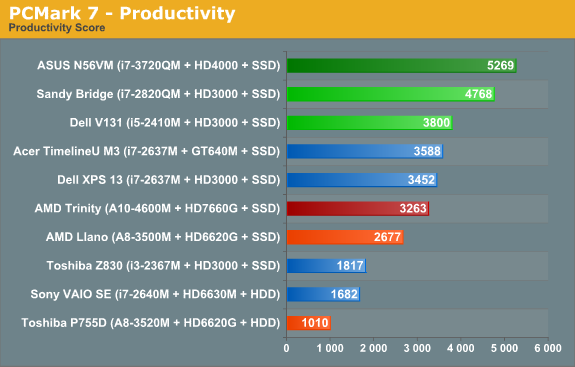

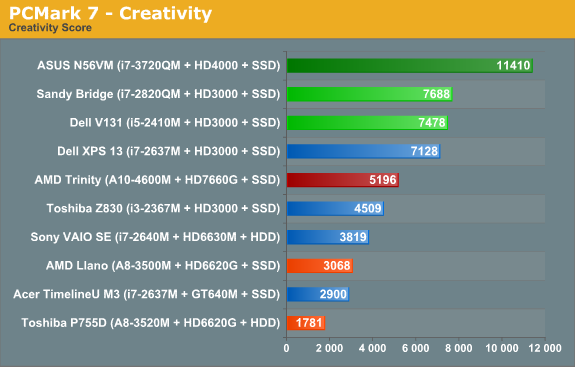
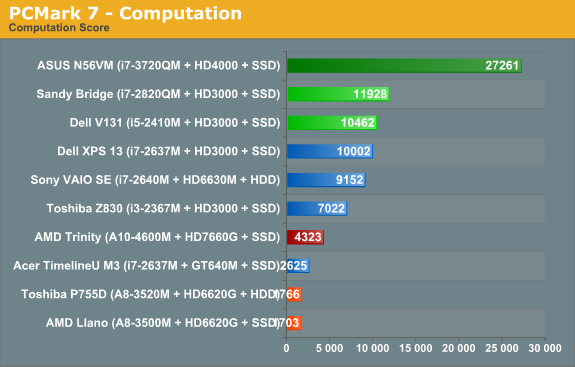
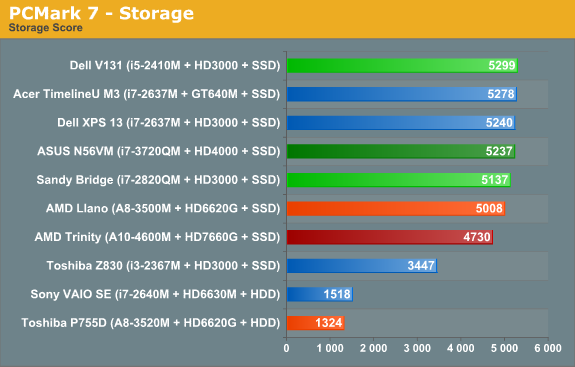
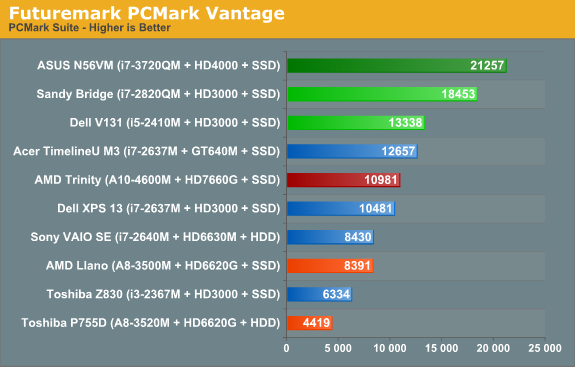
As noted earlier, we ran several other laptops through PCMark 7 and PCMark Vantage testing using the same Intel 520 240GB SSD, plus all the ultrabooks come with SSDs. That removes the SSD as a factor from most of the PCMark comparisons, leaving the rest of the platform to sink or swim on its own. And just how does AMD Trinity do here? Honestly, it’s not too bad, despite positioning within the charts.
Obviously, Intel’s quad-core Ivy Bridge is a beast when it comes to performance, but it’s a 45W beast that costs over $300 just for the CPU. We’ll have to wait for dual-core Ivy Bridge to see exactly how Intel’s latest stacks up against AMD, but if you remember the Llano vs. Sandy Bridge comparisons it looks like we’re in for more of the same. Intel continues to offer superior CPU performance, and even their Sandy Bridge ULV processors can often surpass Llano and Trinity. In the overall PCMark 7 metric, Trinity ends up being 20% faster than a Llano A8-3500M laptop, while Intel’s midrange i5-2410M posts a similar 25% lead on Trinity. Outside of the SSD, we’d expect Trinity and the Vostro V131 to both sell for around $600 as equipped.
A 25% lead for Intel is pretty big, but what you don’t necessarily get from the charts is that for many users, it just doesn’t matter. I know plenty of people using older Core 2 Duo (and even a few Core Duo!) laptops, and for general office tasks and Internet surfing they’re fine. Llano was already faster in general use than Core 2 Duo and Athlon X2 class hardware, and it delivered great battery life. Trinity boosts performance and [spoiler alert!] battery life, so it’s a net win. If you’re looking for a mobile workstation or something to do some hardcore gaming, Trinity won’t cut it—you’d want a quad-core Intel CPU for the former, and something with a discrete GPU for the latter—but for everything else, we’re in the very broad category known as “good enough”.


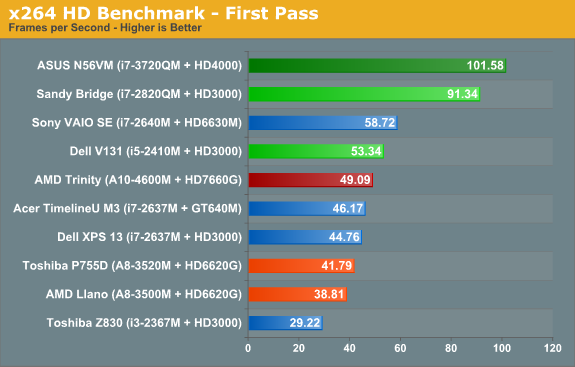
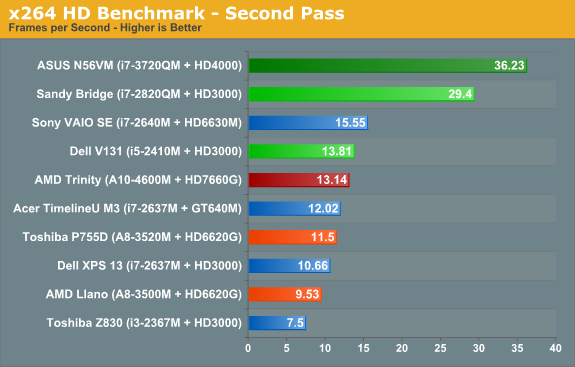
When we start drilling down into other performance metrics, AMD’s CPU performance deficiency becomes pretty obvious. The Cinebench single-threaded score is up 15% from 35W Llano, but in a bit of a surprise the multi-threaded score is basically a wash. Turn to the x264 HD encoding test however and Trinity once again shows a decent 15% improvement over Llano. Against Sandy Bridge and Ivy Bridge, though? AMD’s Trinity doesn’t stand a chance: i5-2410M is 50% faster in single-threaded Cinebench, 27% faster in multi-threaded, and 5-10% faster in x264. It’s a good thing 99.99% of laptop users never actually run applications like Cinebench for “real work”, but if you want to do video encoding a 10% increase can be very noticeable.

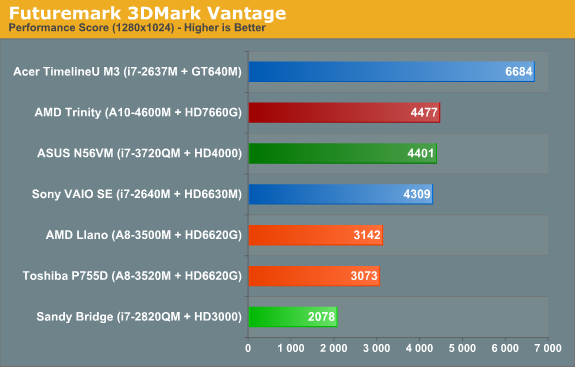
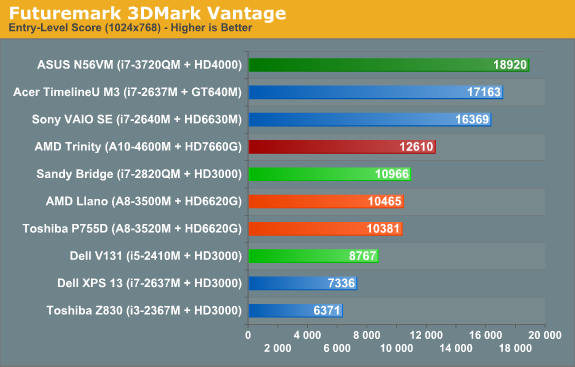
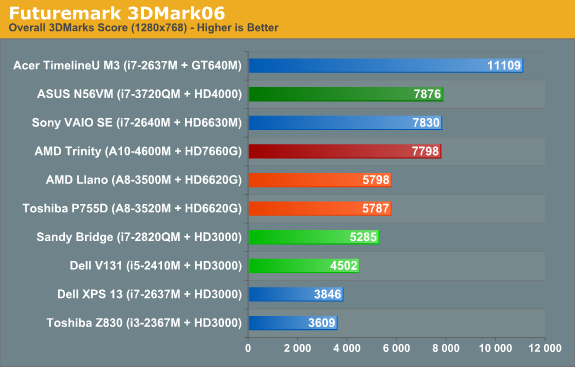
Shift over to graphics oriented benchmarks and the tables turn once again...sort of. Sandy Bridge can’t run 3DMark11, since it only has a DX10 class GPU, but in Vantage Performance and 3DMark06 Trinity is more than twice as fast as HD 3000. Of course, Ivy Bridge’s HD 4000 is the new Intel IGP Sheriff around these parts, and interestingly we see Trinity and i7-3720QM basically tied in these two synthetics. (We’ll just ignore 3DMark Vantage’s Entry benchmark, as it’s so light on graphics quality that we’ve found it doesn’t really stress most GPUs much—even low-end GPUs like HD 3000 score quite well.) We’ll dig into graphics performance more with our gaming benchmarks next.










271 Comments
View All Comments
scope54 - Wednesday, May 16, 2012 - link
I'd like to see how much faster Piledriver is compared to a Bulldozer CPU with roughly the same specs (like an FX-4100 under-clocked to match speeds), to get an idea of what we can expect when the desktop variant releases.Arbie - Wednesday, May 16, 2012 - link
I would really have liked to have seen this! Of course none of these chips will run the game at high settings, but what will they do at lower res??? Contrary to all the nonsense printed especially on its release, Crysis was a great game even at low res AND was incredibly scalable both up and down. It remains a great yardstick for comparisions because (a) it is still challenging and (b) we have so much history with it.
Can you please at least add some average and minimum framerates, if in fact any settings were playable?
MySchizoBuddy - Thursday, May 17, 2012 - link
Is it still PCI-e 2?JarredWalton - Wednesday, May 23, 2012 - link
Yes. PCIe 3.0 is not needed for lower performance parts, and Trinity laptops aren't going to be paired with high-end GPUs I don't think. I feel like it's already hitting CPU bottlenecks in some games even with the HD 7660G!ArteTetra - Thursday, May 17, 2012 - link
"What’s Makes a Trinity?"What's this? A citation, or a kind of slang? I really don't understand the usage of two verbs (my native language is not English).
Drewdog343 - Sunday, May 20, 2012 - link
A typo =PTargon - Saturday, July 7, 2012 - link
I suspect it is a play on words. Trinity is the code name for this new generation of AMD APUs, so there has been the question about why AMD gave it this code name.silverblue - Thursday, May 17, 2012 - link
Then don't read them. Really, if you don't value what he has to say, then you're just doing yourself a disservice by adding comments.There really isn't any need to become all aggressive over your disdain for Jarred.
silverblue - Thursday, May 17, 2012 - link
If you've seen it in the article, then it's hardly "buried". He has also reiterated this point in the comments.In any case, Jarred is spot on - an SB laptop with dGPU wouldn't be much more expensive (if at all) and would perform better, however Trinity would excel in terms of power consumption. For a lot of people, its CPU performance would be more than enough, and it has easily the strongest IGP.
edge929 - Thursday, May 17, 2012 - link
WTB Trinity A10 for a new HTPC, ETA?